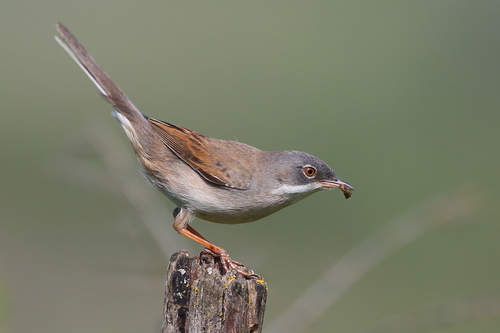
Common Whitethroat
The Common Whitethroat (Curruca communis) is a widespread and familiar songbird found throughout Europe and across large parts of temperate Asia and wintering in Africa. It is known for its scratchy, distinctive song and its habit of singing from prominent perches, often in hedgerows and scrubland. Ecologically, it plays a role in insect control and seed dispersal. While not currently globally threatened, its populations are sensitive to changes in agricultural practices and habitat loss. The Common Whitethroat holds no particular major cultural significance, but it's a welcome sign of spring for many birdwatchers.
13-15 cm
Length
18-23 cm
Wingspan
Least Concern
Conservation Status
Distribution
Breeds across Europe (except the far north) and temperate Asia, extending eastwards to central Siberia. Migrates to sub-Saharan Africa for the winter, with some populations wintering in North Africa and the Arabian Peninsula. Altitudinal range varies from sea level to mountain slopes up to 2500m.
Lifespan
Typically 1-2 years in the wild, although some individuals may live longer.
Common Whitethroat's Habitat
Habitat Types
Open woodland, Hedgerows, Scrubland, Farmland with bushes, Heathland, Young plantations
Climate Zones
Temperate, Boreal (southern edges)
Adaptations
Prefers habitats with dense, low vegetation for nesting and foraging, with scattered taller perches for singing.
Variations
Several subspecies are recognized, differing slightly in plumage and size. For example, *C. c. icterops* found in Eastern Europe and Asia is slightly larger and greyer.
Appearance
Breeding Plumage
Breeding males have a grey head, white throat, brownish upperparts, and buffish underparts. Females are duller, with a browner head and less contrasting throat. Non-breeding plumage is similar, but often more washed-out.
Seasonal Feather Changes
Some wear and fading of plumage occurs throughout the breeding season.
Sex Based Plumage Differences
Males have a more distinct grey head and brighter white throat than females.
Notable Features
White throat (more prominent in males), Rufous fringes to wing feathers, Relatively long tail, often flicked upwards
Diet and Feeding
Primary Foods
Insects, Spiders, Berries, Small fruits
Foraging Behavior
Actively gleans insects and spiders from foliage, often hopping and flitting through low vegetation. Will also take berries and fruits, especially in late summer and autumn.
Specializations
No highly specialized feeding adaptations, but its agility and small size allow it to forage effectively in dense vegetation.
Seasonal Diet Variations
Primarily insectivorous during the breeding season, switching to a more frugivorous diet in late summer and autumn before migration.
Behavior
Social Structure
Generally solitary or in pairs during the breeding season. May form small flocks during migration.
Communication
Scratchy, warbling song, Harsh 'churr' calls, Visual displays (e.g., flicking tail)
Migration
A long-distance migrant, traveling between breeding grounds in Europe and Asia and wintering grounds in Africa. Migrates at night.
Territorial or Group Behaviors
Males are territorial during the breeding season, defending their nesting area against rivals.
Conservation
Threats
Habitat loss (due to agricultural intensification and urbanization), Pesticide use (reducing insect prey), Climate change (potentially affecting migration and breeding success)
Protection Programs
Agri-environment schemes (promoting wildlife-friendly farming practices), Habitat restoration projects
Local National Laws
Protected under various national and international wildlife legislation (e.g., the EU Birds Directive).
Population Trend
Decreasing in some regions, particularly in Western Europe, but overall population is considered stable.
Population Estimates
Global population estimated to be 23,800,000 - 41,700,000 mature individuals.
Interesting Facts
The Common Whitethroat is known for its habit of singing from prominent perches.
This makes it relatively easy to spot, despite its often-secretive nature.
They undertake a remarkable migratory journey.
Traveling thousands of kilometers between Europe/Asia and Africa twice a year.
Their diet shifts significantly with the seasons.
Reflecting the availability of different food sources.
Faqs about Common Whitethroat
What does a Common Whitethroat sound like?
Its song is a scratchy, fast warble, often described as 'chattering' or 'scolding'.
Where can I see a Common Whitethroat?
Look for them in open habitats with low vegetation and scattered bushes, such as hedgerows, scrubland, and farmland.
Are Common Whitethroats endangered?
No, they are currently classified as 'Least Concern' by the IUCN, but their populations are declining in some areas.
Do both male and female sing?
Primarily the male sings to establish territory and attract a mate. Females may have quieter subsongs, but not the full, loud song of the male.
Copyright @ Nature Style Limited. All Rights Reserved.
 English
English